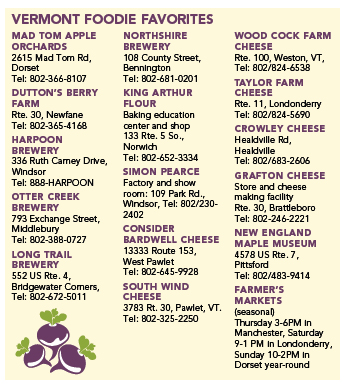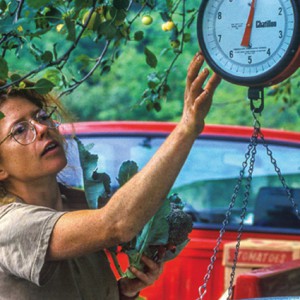It is so interesting to observe the changes that have occurred in Vermont’s food industry over the last several years. Vermont is no longer famous for just its deerskin gloves and cheddar cheese but has blossomed into a foodie paradise with cheese makers offering cow, goat and sheep cheeses of all varieties including world class cheddars as well as boutique sausage makers, bread makers and a multitude of craft beer brewers. Farmers’ markets of the highest quality have sprung up in every community in the state, and are a fabulous substitute for my own long gone gardens. Locally produced honey, apples, berries and the all–pervasive Vermont maple syrup as well as game birds and venison are all readily available in local markets and farm stores. In fact, the new term “Locavore” was instantly embraced here in Vermont as we are encouraged by all this bounty to buy locally. Who knows what is coming next but I look forward to it all.
I have been writing about Vermont country cooking for nearly two decades now, and at a certain point a few years back I decided to hit the road in search of growers, markets, craftspeople and cooks to experience the state’s “foodie” explosion for myself. This turned out to be a swell idea, as this state is such an amazing treat for the eyes no matter what season of the year—always a big plus when it comes to road trips. But Vermont has also become one of the most interesting states in the union food-wise.
Cheese
One of my first junkets was into the world of artisan cheese. Now cheese trips have become a constant in my travels because there are so many boutique cheese makers in the state. No one could ever cover them all in a single outing. Southern Vermont has its share and they vary from very small to the Grafton Cheese Company in Grafton that also has a large operation in Brattleboro where they sell cheeses from all over the state plus gourmet jellies, crackers and you name it. A very interesting old cheese maker is the Crowley Cheese Company over near Okemo, whose specialty is cheddar, harkening back. The cheese making process and the tasting are all worth a look.
Vermont has been called the Napa Valley of cheese. Its smallness makes it a perfect place for producers of small batch quality cheese. Instead of large volume milk producers that make huge quantities of one kind of cheese, little rural Vermont is home to many tiny herds of animals—goats, cows, sheep—which produce specific kinds of hand-made premium cheese. These cheese producers have banded together, more or less, into a representative body called the Vermont Cheese Council. It’s mainly a public relations entity that hosts educational events for the public and for food professionals—anything that will promote the art and science of artisan and farmstead cheeses made in the state.
For my purposes the best thing the council has done is create the Vermont Cheese Trail which you can find on their website. It’s a map of 45 cheese producers in the state who don’t mind visitors, along with their addresses and contact information so that you can visit the farms, meet the cheese makers and see the production for yourself.
Any little journey through Southern Vermont could be considered a food junket.
Vermonters are a special breed and meeting some of the cheese makers in person was almost a bigger treat than tasting their cheese. Even when they were not at home. One case in particular I think of as being indicative of the Vermont way of life that we all know and love so well. Let me elucidate. One afternoon I planned to visit two cheese makers—South Wind Farm in North Rupert and Consider Bardwell Farm with their magnificent herd of Oberhaslis goats in West Pawlet.
I pulled into South Wind Farm and parked next to a little milking shack adjacent to a large cow farm. A sign on the side of the shack said “cheese for sale”, so I went in. There was no one on the premises, but there was a refrigerator filled with neatly packaged and priced South Wind Farmstead Raclette. Nearby was a place to leave the money for the cheese and so I took some cheese, left my money and drove on. I later found the Raclette to be absolutely delicious. These very trusting people make their South Wind Farmstead Cheese from their own herd of prize Holsteins and may I say, God bless ‘em. May they prosper long and always be so kind and trusting.
Beer
Travelling around southern Vermont visiting local beer brewers was a hoot! Everyone was extremely welcoming and enthusiastic about their product. Taste tests were ubiquitous. Fortunately most breweries served food to go along with the little shots of beer sold as a tasting. The beer was usually presented in a rack of three to six types including a description of each, and experts were always around to answer questions.
 The biggest plant was at Harpoon in Windsor, right next to the newish Simon Pearce manufacturing facility, also worth a visit. When I visited Harpoon it was in the fall and very busy with a bicycle race going on all around the premises with most of the mountain ski schools competing. The tour of the brewery that was the most comprehensive of any brewery we visited. Harpoon also has a large restaurant with inside service and outside service beside a fire pit. It is well worth a road trip and you could include a visit to the home, studios and gardens of Augustus Saint-Gaudens, one of America’s greatest sculptors across the river in New Hampshire if you have a little extra time.
The biggest plant was at Harpoon in Windsor, right next to the newish Simon Pearce manufacturing facility, also worth a visit. When I visited Harpoon it was in the fall and very busy with a bicycle race going on all around the premises with most of the mountain ski schools competing. The tour of the brewery that was the most comprehensive of any brewery we visited. Harpoon also has a large restaurant with inside service and outside service beside a fire pit. It is well worth a road trip and you could include a visit to the home, studios and gardens of Augustus Saint-Gaudens, one of America’s greatest sculptors across the river in New Hampshire if you have a little extra time.
I found that my favorite beer was something called Hefeweizen, which is described as a south German wheat beer, dry and tart with modest alcohol levels and when poured into the proper glass can be “one sexy looking beer” (and I quote). I’ve never really been much of a beer drinker, so who would have thought I would ever find a “favorite beer”, but there it is.
Among other brewers that I visited on my beer odyssey were Longtrail in Bridgewater Corners near Woodstock and Otter Creek in Waterbury. Both had food service and both were very informative and glad to see me. It always amazes me how many types of beer, seasonal and otherwise, are available to please any taste. No wonder these craft beers have become so popular.
Bread
I’ve always loved to bake. And King Arthur Flour has always been my favorite flour. The company has been around since 1790! (Just imagine. They were making flour for the Pilgrims.) And just recently they built a brand new education center in Norwich where you can take classes on just about any aspect of baking you can think of. Sounded like a perfect foodie junket to me, so I signed up and made my way north to America’s oldest flour company.
The education center is beautiful—clean, bright, modern and fully equipped. The list of guest instructors is long and impressive (and includes Martha Stewart among many others, in case you’re interested). The list of classes you can take ranges from introductory demonstrations for beginners to intensive weeklong courses for the professional, with a wide variety of hands-on classes for both adults and children. You can learn to make pizza dough, ciabatta, piecrusts, croissants, gingerbread houses and much, much more.
All bakers are welcome, no matter what their skill level or baking interest might be. I decided to stick with the basics and took a class in basic French bread. My class was typically small, which encourages one-on-one learning, and my instructor truly seemed to enjoy being in the classroom with us.
We all left with extra dough to bake at home. I can’t wait to go back and take a class in something really fancy. King Arthur offers a wide range of private classes, on virtually any baking topic. Wouldn’t it be fun to schedule a private class with a group of like-minded baking pals?
…and More
Really any little journey through Southern Vermont could be considered a foodie junket. In the summer, there are strawberries and blueberries to be picked at the farms all along Route 30 from Brattleboro to Manchester and on into Granville, NY. I stopped by the New England Maple Museum in Pittsford one day, and I spend happy hours every week at the farmers’ markets in the towns around us. Who needs fancy organic markets when we can buy freshly picked organic produce, locally made cheeses, jams, jellies, mustards, pickles, even kimchee, grass fed beef and free range chickens and eggs, pheasants, baked items and much, much more right here in our own backyard.
Photography by Hubert Schriebl


